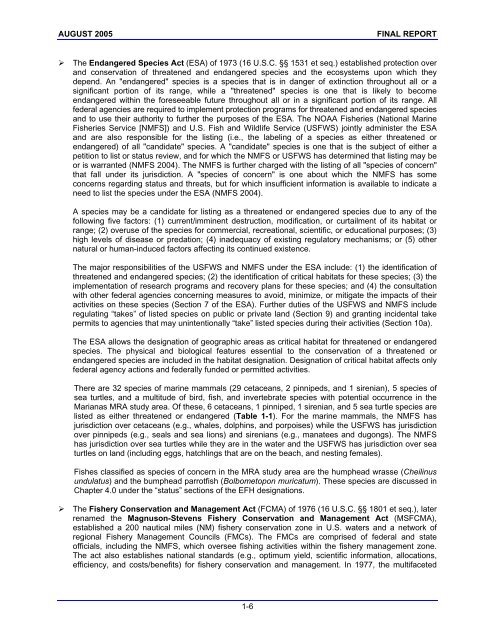Marine Resources Assessment for the Marianas Operating ... - SPREP
Marine Resources Assessment for the Marianas Operating ... - SPREP
Marine Resources Assessment for the Marianas Operating ... - SPREP
You also want an ePaper? Increase the reach of your titles
YUMPU automatically turns print PDFs into web optimized ePapers that Google loves.
AUGUST 2005 FINAL REPORT<br />
The Endangered Species Act (ESA) of 1973 (16 U.S.C. §§ 1531 et seq.) established protection over<br />
and conservation of threatened and endangered species and <strong>the</strong> ecosystems upon which <strong>the</strong>y<br />
depend. An "endangered" species is a species that is in danger of extinction throughout all or a<br />
significant portion of its range, while a "threatened" species is one that is likely to become<br />
endangered within <strong>the</strong> <strong>for</strong>eseeable future throughout all or in a significant portion of its range. All<br />
federal agencies are required to implement protection programs <strong>for</strong> threatened and endangered species<br />
and to use <strong>the</strong>ir authority to fur<strong>the</strong>r <strong>the</strong> purposes of <strong>the</strong> ESA. The NOAA Fisheries (National <strong>Marine</strong><br />
Fisheries Service [NMFS]) and U.S. Fish and Wildlife Service (USFWS) jointly administer <strong>the</strong> ESA<br />
and are also responsible <strong>for</strong> <strong>the</strong> listing (i.e., <strong>the</strong> labeling of a species as ei<strong>the</strong>r threatened or<br />
endangered) of all "candidate" species. A "candidate" species is one that is <strong>the</strong> subject of ei<strong>the</strong>r a<br />
petition to list or status review, and <strong>for</strong> which <strong>the</strong> NMFS or USFWS has determined that listing may be<br />
or is warranted (NMFS 2004). The NMFS is fur<strong>the</strong>r charged with <strong>the</strong> listing of all "species of concern"<br />
that fall under its jurisdiction. A "species of concern" is one about which <strong>the</strong> NMFS has some<br />
concerns regarding status and threats, but <strong>for</strong> which insufficient in<strong>for</strong>mation is available to indicate a<br />
need to list <strong>the</strong> species under <strong>the</strong> ESA (NMFS 2004).<br />
A species may be a candidate <strong>for</strong> listing as a threatened or endangered species due to any of <strong>the</strong><br />
following five factors: (1) current/imminent destruction, modification, or curtailment of its habitat or<br />
range; (2) overuse of <strong>the</strong> species <strong>for</strong> commercial, recreational, scientific, or educational purposes; (3)<br />
high levels of disease or predation; (4) inadequacy of existing regulatory mechanisms; or (5) o<strong>the</strong>r<br />
natural or human-induced factors affecting its continued existence.<br />
The major responsibilities of <strong>the</strong> USFWS and NMFS under <strong>the</strong> ESA include: (1) <strong>the</strong> identification of<br />
threatened and endangered species; (2) <strong>the</strong> identification of critical habitats <strong>for</strong> <strong>the</strong>se species; (3) <strong>the</strong><br />
implementation of research programs and recovery plans <strong>for</strong> <strong>the</strong>se species; and (4) <strong>the</strong> consultation<br />
with o<strong>the</strong>r federal agencies concerning measures to avoid, minimize, or mitigate <strong>the</strong> impacts of <strong>the</strong>ir<br />
activities on <strong>the</strong>se species (Section 7 of <strong>the</strong> ESA). Fur<strong>the</strong>r duties of <strong>the</strong> USFWS and NMFS include<br />
regulating “takes” of listed species on public or private land (Section 9) and granting incidental take<br />
permits to agencies that may unintentionally “take” listed species during <strong>the</strong>ir activities (Section 10a).<br />
The ESA allows <strong>the</strong> designation of geographic areas as critical habitat <strong>for</strong> threatened or endangered<br />
species. The physical and biological features essential to <strong>the</strong> conservation of a threatened or<br />
endangered species are included in <strong>the</strong> habitat designation. Designation of critical habitat affects only<br />
federal agency actions and federally funded or permitted activities.<br />
There are 32 species of marine mammals (29 cetaceans, 2 pinnipeds, and 1 sirenian), 5 species of<br />
sea turtles, and a multitude of bird, fish, and invertebrate species with potential occurrence in <strong>the</strong><br />
<strong>Marianas</strong> MRA study area. Of <strong>the</strong>se, 6 cetaceans, 1 pinniped, 1 sirenian, and 5 sea turtle species are<br />
listed as ei<strong>the</strong>r threatened or endangered (Table 1-1). For <strong>the</strong> marine mammals, <strong>the</strong> NMFS has<br />
jurisdiction over cetaceans (e.g., whales, dolphins, and porpoises) while <strong>the</strong> USFWS has jurisdiction<br />
over pinnipeds (e.g., seals and sea lions) and sirenians (e.g., manatees and dugongs). The NMFS<br />
has jurisdiction over sea turtles while <strong>the</strong>y are in <strong>the</strong> water and <strong>the</strong> USFWS has jurisdiction over sea<br />
turtles on land (including eggs, hatchlings that are on <strong>the</strong> beach, and nesting females).<br />
Fishes classified as species of concern in <strong>the</strong> MRA study area are <strong>the</strong> humphead wrasse (Cheilinus<br />
undulatus) and <strong>the</strong> bumphead parrotfish (Bolbometopon muricatum). These species are discussed in<br />
Chapter 4.0 under <strong>the</strong> “status” sections of <strong>the</strong> EFH designations.<br />
The Fishery Conservation and Management Act (FCMA) of 1976 (16 U.S.C. §§ 1801 et seq.), later<br />
renamed <strong>the</strong> Magnuson-Stevens Fishery Conservation and Management Act (MSFCMA),<br />
established a 200 nautical miles (NM) fishery conservation zone in U.S. waters and a network of<br />
regional Fishery Management Councils (FMCs). The FMCs are comprised of federal and state<br />
officials, including <strong>the</strong> NMFS, which oversee fishing activities within <strong>the</strong> fishery management zone.<br />
The act also establishes national standards (e.g., optimum yield, scientific in<strong>for</strong>mation, allocations,<br />
efficiency, and costs/benefits) <strong>for</strong> fishery conservation and management. In 1977, <strong>the</strong> multifaceted<br />
1-6
















